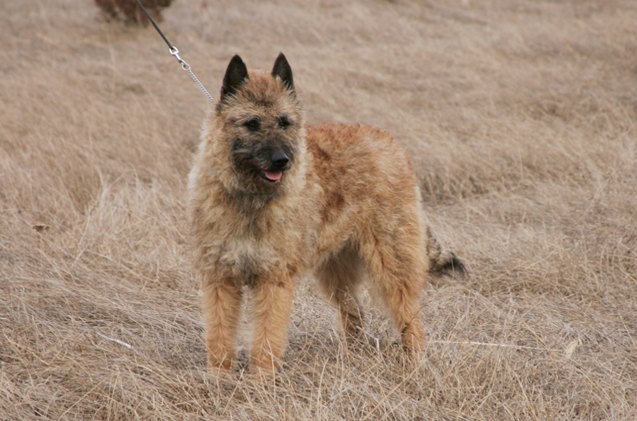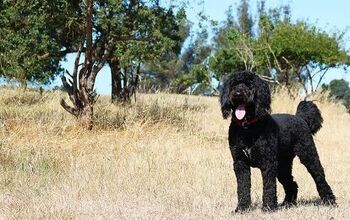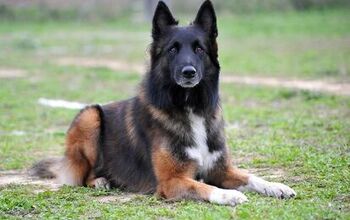Belgian Laekenois


About Belgian Laekenois
Bred to herd and protect, the Belgian Laekenois still has these instincts. He is strong, intelligent and protective however; without intense training, he can try to become the leader of the family. The Laekenois truly enjoys training sessions, so long as they are done with positive methods and reinforcement. Just because he is a herding dog, doesn’t mean that he lacks good looks! The tousled-look is intentional for the breed and his expressive eyes can melt his owner’s heart.
The Belgian Laekenois is not a suitable choice for families with young children or other pets. This breed does not accept strangers readily so families who entertain a lot should not consider this breed. To learn more about the Belgian Laekenois, please continue reading.
Bred to herd and protect, the Belgian Laekenois still has these instincts.
Originating in Flanders, Belgium, the Belgian Laekenois is believed to have been around since the Middle Ages. These bright dogs were bred to herd and protect sheep and ensure that the flax crops were not tampered with. They were also used to stand guard over linens while they were set out to dry in the fields. Today, the Belgian Laekenois is a loyal companion who will fiercely protect his family and home.
This breed’s development is unknown due to the antiquity of its origin. It is one of the four known dog breeds that were developed in Belgium. Originally, all of these breeds were classified together but now are considered to be separate breeds. It’s interesting to note that the Laekenois was used as a courier for the troops during both World Wars. This caused a drastic reduction in the breed’s population however; concerned enthusiasts worked diligently to increase the population of the Belgian Laekenois.
Because the Belgian Laekenois is an athletic and energetic breed, he needs to be fed a diet of high-quality food. Dry kibble is suggested as wet foods can cause dental and oral health problems.
Although the Laekenois is a bright dog, he requires an owner who will be dedicated to regular training sessions for the life of the dog.
Although the Laekenois is a bright dog, he requires an owner who will be dedicated to regular training sessions for the life of the dog. Being a herding and guard dog, this breed attaches closely to his home and family and does not like outsiders being around. Early socialization and puppy kindergarten classes can help the Belgian Laekenois to become accepting of strangers. It is important to note that without training and social skills, this breed can become aggressive with strangers.
Positive training techniques work best for the Laekenois. Manhandling or other forceful methods will only increase the dog’s aggression. An assertive yet kind owner using praise and yummy rewards is the key to having a well-behaved Belgian Laekenois.
The Belgian Laekenois should weigh between 55 and 65 pounds and stand between 22 and 26 inches tall at the withers. Males should be larger than females.
Bold and courageous, the Laekenois are quite impressive watchdogs. They are extremely protective of their families and homes however; they tend to be the pack leader as well. This domination factor can prove to be problematic. Dogs fight to determine their rankings in the pack. This, coupled with the breed’s tendencies toward aggressive behavior, can be a recipe for disaster if the owner isn’t assertive and consistent in keeping the Belgian Laekenois in check. He is not welcoming of strangers and can be unreliable with children and other animals. This breed is not for everybody.
With proper socialization and consistent training, the Belgian Laekenois can make a trusted companion. This being said, he would always need constant supervision when children, animals or strangers are around. Again, this is not the right breed for everyone.
The Belgian Laekenois is predisposed to several worrisome conditions. Because of his size and activity level, elbow and hip dysplasia has been reported. Other issues include progressive retinal apathy, pannus, cataracts, hypothyroidism and epilepsy. Gastric carcinoma, which is cancer of the stomach, has also been seen within the breed. Because of his sensitive skin, the Belgian Laekenois may have skin allergies.
The Laekenois usually lives to be between 10 and 14 years old.
Bred to be a herding and watchdog, the Belgian Laekenois has loads of energy and must be able to burn it off. Long walks each day will help with his exercise and socialization needs however; the dog also needs to run and play hard too. He quickly can learn to catch a Frisbee, an activity that will allow him to work a variety of muscles. Fetch is another good form of exercise.
The Laekenois does well in agility, tracking, herding and other competitive dog sports. These activities require loads of training which will make the dog more social and accepting of others.
Bold and courageous, the Laekenois are quite impressive watchdogs.
The American Kennel Club writes: “The Laekenois’ original duty, in addition to guarding and tending the flock, was to guard linen drying in the fields. The breed also served as a messenger dog during World War I and II, which decreased the breed’s numbers. Many breeders worked very hard to restore this variety, while retaining the typical Belgian Shepherd Dog intelligence, type and structure. Today, the breed is still able to herd and guard its flock, and protect its people and property”. The AKC first recognized the Belgian Laekenois in 2011.
The Laekenois’ double coat is long, rough and wooly. It is an excellent protection for the dog in inclement weather. Both straight and wavy coats are acceptable. The wool-like appearance gives the dog a tousled and unkempt look, even after he has been professionally groomed. The coats rarely form mats and are a fawn or reddish fawn in color. The muzzle and tail may have black traces and shading.
The Belgian Laekenois’ coat is not at all high maintenance. A thorough brushing each week should keep him looking good and his skin healthy. This breed’s skin is sensitive so do not brush hard. Bathing should only be done when absolutely necessary.
Puppies require loads of socialization if they are to grow up to be tolerant of other people and animals. Training and socialization should begin as soon as your new puppy comes home. Puppy kindergarten classes are a great way to do both. Laekenois puppies usually chew things up as they are teething or because they are bored. The home should be puppy-proofed prior to his arrival. Lots of hard toys and chews should be provided to divert him away from your furniture or your body.

Amy Tokic, Editor of PetGuide.com, is a passionate animal lover and proud pet parent of Oscar, a Shih Tzu/Chihuahua cross, and Zed, a Japanese Chin. Her love of animals began in kindergarten, when she brought her stuffed dog Snoopy into class with her every day. Now, she writes about her adventures in pet ownership and tirelessly researches products, news and health related issues she can share with other animal enthusiasts. In her free time, Amy loves perusing used book and record stores, obsessing over the latest pet products available and chasing squirrels with wild abandon (a habit attributed to spending too much time with her pooches).
More by Amy Tokic

























